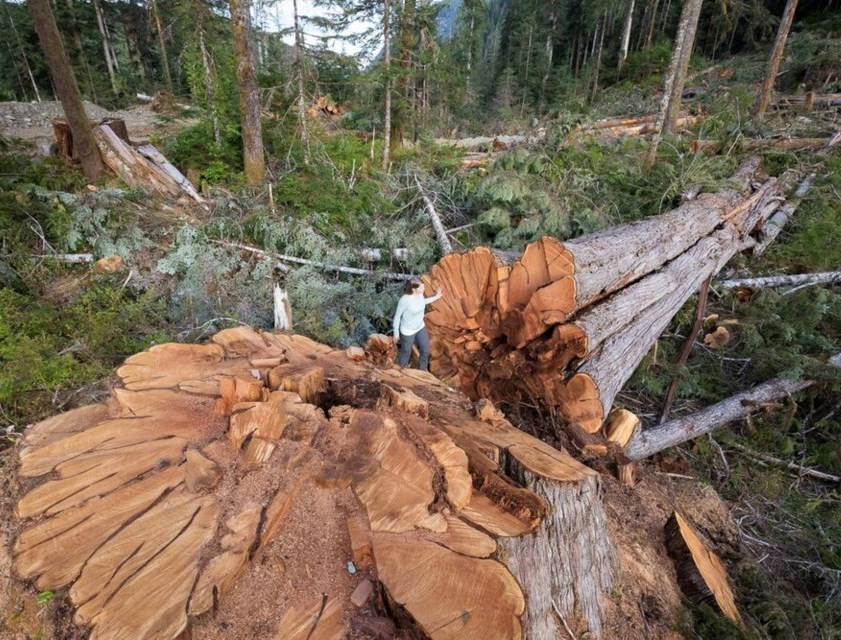Premier John Horgan is under increasing pressure to halt old-growth logging on B.C.’s coast, a step that would come with a billion-dollar price tag to buy back existing timber rights, according to one industry analyst.
In addition to continuing protests at Fairy Creek on Vancouver Island, the most recent pressure included an open letter from the environmental group Canopy, which calls on Horgan to “protect the irreplaceable” old-growth forests.
The letter, signed by prominent scientists and celebrities including primatologist Jane Goodall and William Shatner of Star Trek fame, was published as an ad in the Globe and Mail.
In a rough estimate, industry analyst Jim Girvan calculated it could cost $1.7 billion to cancel the existing timber rights held by companies and First Nations to halt old-growth logging, with old-growth trees still representing 50 per cent of the coastal timber harvest.
“There’s one analyst’s back-of-the-envelope estimate of what it would cost to buy out an industry that William Shatner wants closed,” said Girvan. “So we’re talking big, big money.”
A spokesperson for the Sierra Club of B.C. said some of the economic impacts are being overstated before government makes its decisions. Successive governments, however, have allowed “unsustainable [harvests] to remain very high,” said campaigner Jens Wieting.
The Sierra Club was a supporter of another of the pressure points on government, an international petition by the German environmental group Rainforest Rescue that collected 260,000 signatures calling on government to “stop the felling of ancient giants.”
Horgan’s government has promised new forest management legislation as part of its legislative agenda this fall and the premier has alluded to the “people that will be affected by the decisions we’re going to be making” in media interviews.
In an interview with CFAX radio in Victoria, Horgan said government is doing its best to implement “the spirit and intent” of the recommendations of the old-growth strategic review it commissioned in 2020, but noted it has to be fair to those who were granted timber rights by previous governments.
In the radio interview, Horgan said that he would prefer if the signatories to Canopy’s letter would “put down a couple of million bucks each” to help mitigate the impact of old-growth deferrals, though his minister on the file didn’t offer an own estimate on what the costs might be in response to media questions.
Katrine Conroy, minister of Forests, Lands and Natural Resource operations, wasn’t available for an interview but her staff forwarded an unattributed email response that said government agrees “on the need to measure the impacts on people, and this work is underway.”
Ministry staff didn’t refute Girvan’s rough estimate, but in the statement said: “A socio-economic analysis is currently being conducted on the issue.”
The statement said government in June created an old-growth technical advisory panel to help the province identify the most at-risk old-growth forests to be considered for two-year deferrals from logging, which would also involve engagement with First Nations’ rights and titleholders.
“We know some forests are irreplaceable and need protection, and [we] are committed to moving in the right direction to secure a better future for our kids,” the statement said.
Girvan said industry understands that logging deferrals and further protection of old growth is in the cards but “is fearful that there’s going to be a massive disruption of harvesting.”
Over the summer, Girvan, in an estimate compiled for a coalition of B.C. pulp-and-paper producers, tried to estimate how much timber harvests could be reduced to accommodate a range of pressures facing government, including old-growth preservation.
“We forecasted that at least four sawmills on the coast would close,” Girvan said, estimating that government might act on logging deferrals in forests identified by environmental groups as endangered ecosystems.
Then a paper mill would also be at risk for closure, Girvan said, because pulp-and paper is dependent on wood waste from sawmills to operate.
Wieting, however, said no one knows the details of what is being considered.
“We are talking about a certain portion of B.C.’s forests that would be protected, not all the forests, not all of the old growth,” Wieting said. “We still have to wait to see what the B.C. government is willing to do.”
Wieting didn’t play down the fact that there will be a “significant impact on forestry jobs as we know them today,” which will require considerable public support to cushion.
“There’s a moment of truth for the B.C. government to acknowledge that there’s more value in keeping standing what remains intact and not destroying it for short-term profits,” Wieting said.



